Value Stream Management (VSM) is a comprehensive approach to improving the flow of value through an organization by visualizing, managing, and optimizing value streams. These value streams represent the series of steps an organization takes to deliver products or services to customers, from initial concept to final delivery. VSM aims to enhance efficiency, reduce waste, and ensure that every activity adds value to the end customer. VSM combines lean principles with modern software development practices to create a cohesive framework for continuous improvement. At its core, VSM involves mapping out the entire process, identifying bottlenecks and inefficiencies, and implementing solutions to streamline operations. By visualizing the flow of work, organizations can make data-driven decisions to enhance productivity and responsiveness.
Key Components of Value Stream Management
To fully leverage the potential of VSM, organizations need to understand its key components. These elements provide the foundation for effectively managing and optimizing value streams.
- Value Stream Mapping: This is the first step in VSM, where organizations create a visual representation of the steps involved in delivering a product or service. This map helps identify non-value-added activities and areas for improvement.
- Metrics and Measurement: VSM relies heavily on metrics to track performance and identify areas for enhancement. Common metrics include lead time, cycle time, and throughput, which provide insights into the efficiency of the value stream.
- Continuous Improvement: VSM fosters a culture of continuous improvement by encouraging teams to regularly review and refine their processes. This iterative approach ensures that organizations can adapt to changing market conditions and customer needs.
Benefits of VSM
Implementing VSM offers numerous benefits that significantly impact organizational performance and customer satisfaction. These advantages highlight why VSM is becoming an essential strategy for modern businesses.
- Improved Efficiency: By eliminating waste and optimizing workflows, VSM helps organizations deliver products and services faster and more efficiently.
- Enhanced Collaboration: VSM promotes cross-functional collaboration by providing a unified view of the entire value stream, enabling teams to work together more effectively.
- Increased Transparency: Visualizing the value stream provides greater transparency, allowing stakeholders to see how work progresses and where improvements can be made.
- Better Customer Satisfaction: By focusing on delivering value to the customer, VSM ensures that organizations meet customer expectations and enhance satisfaction.
Implementing VSM
Successfully implementing VSM involves several strategic steps. These steps guide organizations in establishing a structured and effective value stream management system.
- Define the Value Streams: Identify and define the key value streams within your organization. These are the processes that deliver value to your customers.
- Create Value Stream Maps: Develop detailed maps of your value streams, highlighting each step in the process and identifying areas of waste or inefficiency.
- Analyze and Measure: Use metrics to analyze the current performance of your value streams. Identify bottlenecks and areas for improvement.
- Implement Improvements: Develop and implement strategies to address inefficiencies and optimize the flow of value. This may involve adopting new technologies, reorganizing workflows, or changing team structures.
- Monitor and Adjust: Continuously monitor the performance of your value streams and make adjustments as needed. Regularly review metrics and seek feedback from team members to drive ongoing improvement.
Challenges & Considerations
Implementing VSM can present certain challenges. Addressing these challenges is crucial for the successful adoption and sustainability of VSM practices.
- Cultural Resistance: Shifting to a value stream-focused approach may require a significant cultural change within the organization. It’s essential to engage and educate employees about the benefits of VSM.
- Complexity: Mapping and managing complex value streams can be challenging, especially in large organizations with multiple interconnected processes.
- Data Integration: Effective VSM requires integrating data from various sources to provide a comprehensive view of the value stream. This can be technically demanding and may require advanced tools and technologies.
Top 10 Value Stream Management Software
Let’s explore the top 10 Value Stream Management solutions available today. These tools have been selected based on their features, user reviews, and market impact. It’s essential to remember that these rankings may fluctuate as technology evolves, so staying updated with the latest developments is crucial.
1. GitLab

GitLab offers a comprehensive value stream management solution that optimizes software delivery from planning to production. Its platform enhances visibility, reduces time to value, and improves software quality by integrating all DevSecOps stages in one application. GitLab’s AI-powered tools streamline the development process, making it an essential choice for modern software teams.
- End-to-End Integration: GitLab combines planning, development, security, and operations in a single platform, streamlining workflows and reducing toolchain complexity.
- Value Stream Mapping: Enables teams to map out their value stream, identify bottlenecks, and measure key metrics to optimize performance.
- Advanced Analytics: Provides actionable insights through robust analytics, helping teams make data-driven decisions to improve software quality.
- AI-Powered DevSecOps: Integrates AI tools to enhance code security and efficiency, from code review to deployment.
- Scalability: Supports both small teams and large enterprises with features that scale according to the organization’s needs.
- Continuous Integration/Continuous Deployment: Offers powerful CI/CD pipelines that automate testing and deployment, ensuring faster delivery cycles and higher reliability.
2. Swarmia
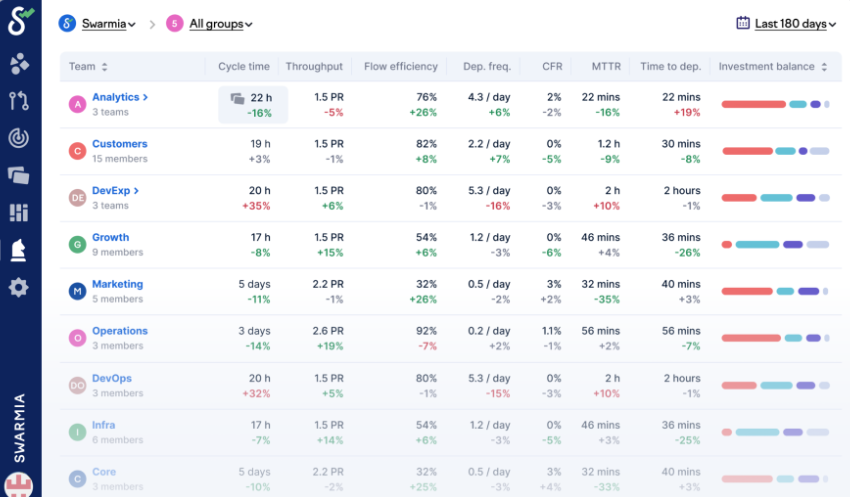
Swarmia is a leading value stream management tool that enhances engineering productivity by providing visibility into workflows and actionable insights. It helps software teams identify bottlenecks, optimize processes, and improve overall efficiency. Swarmia’s comprehensive analytics and benchmarking capabilities make it a crucial tool for continuous improvement.
- Real-Time Visibility: Provides real-time insights into team workflows and productivity metrics.
- Bottleneck Identification: Detects bottlenecks and inefficiencies in the development process.
- Actionable Insights: Delivers actionable insights to help teams make data-driven decisions.
- Integration Capabilities: Seamlessly integrates with popular development tools like GitHub, Jira, and Slack.
- Customizable Dashboards: Allows for the creation of customized dashboards to monitor key performance indicators.
- Benchmarking: Offers benchmarking tools to compare team performance against industry standards and best practices.
3. LinearB
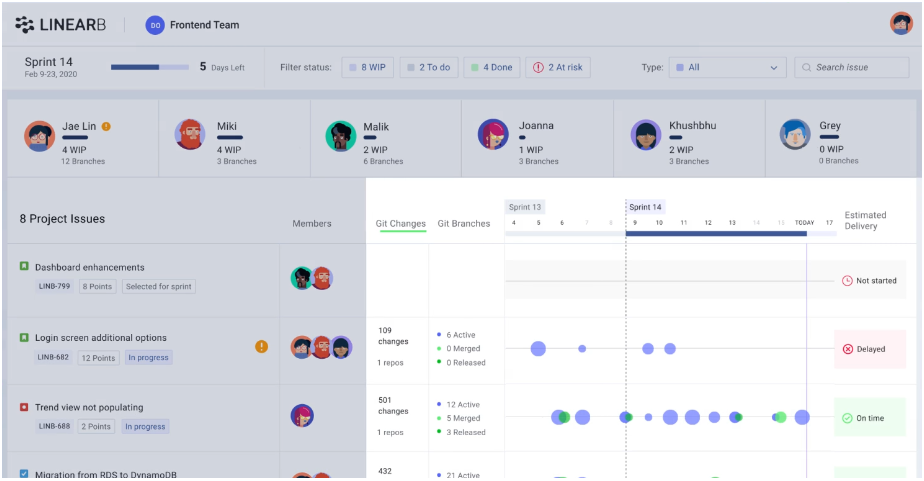
LinearB is a prominent software engineering intelligence platform that enhances operational efficiency and aligns research and development with business goals. It provides tools for value stream management, offering real-time visibility and actionable insights to improve software delivery processes.
- Operational Efficiency: LinearB helps engineering leaders optimize team workflows, reducing bottlenecks and improving overall efficiency.
- Real-Time Metrics:Provides real-time metrics and dashboards to track key performance indicators (KPIs) and identify areas for improvement.
- Integration with DevOps Tools:Seamlessly integrates with popular DevOps tools like Git, Jira, and Slack, providing a unified view of the software development lifecycle.
- Predictive Analytics:Utilizes predictive analytics to forecast delivery timelines and resource needs, aiding in better planning and decision-making.
- Automated Reporting: Automates reporting processes, enabling teams to focus on development rather than administrative tasks.
- Collaboration Enhancement: Facilitates better collaboration within teams through data-driven insights and communication tools, ensuring everyone is aligned with project goals.
4. Jellyfish
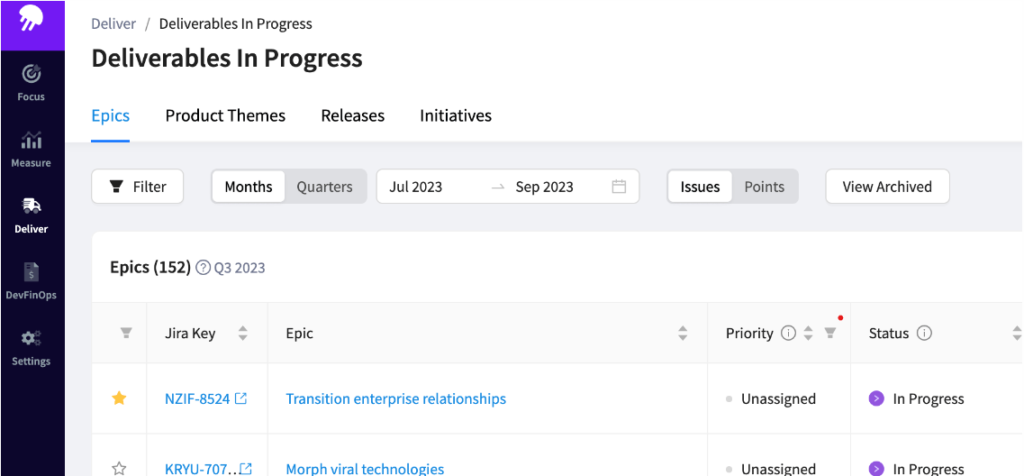
Jellyfish is a credible engineering management platform designed to maximize the impact of software engineering teams. By providing comprehensive visibility into engineering activities, it helps organizations align technical efforts with business goals and improve overall productivity. Jellyfish’s value stream management tool identifies and eliminates bottlenecks to streamline software delivery.
- Engineering Management: Provides detailed insights into engineering activities and productivity metrics.
- Value Stream Mapping: Offers visual representations of end-to-end processes to identify and eliminate inefficiencies.
- Business Alignment: Translates technical data into business-relevant information for better decision-making.
- Bottleneck Identification: Detects bottlenecks in the software delivery process to enhance efficiency.
- Impact Measurement: Measures the impact of engineering efforts on business outcomes.
- Communication: Facilitates communication between engineering teams and business stakeholders to ensure alignment and transparency.
5. Allstacks
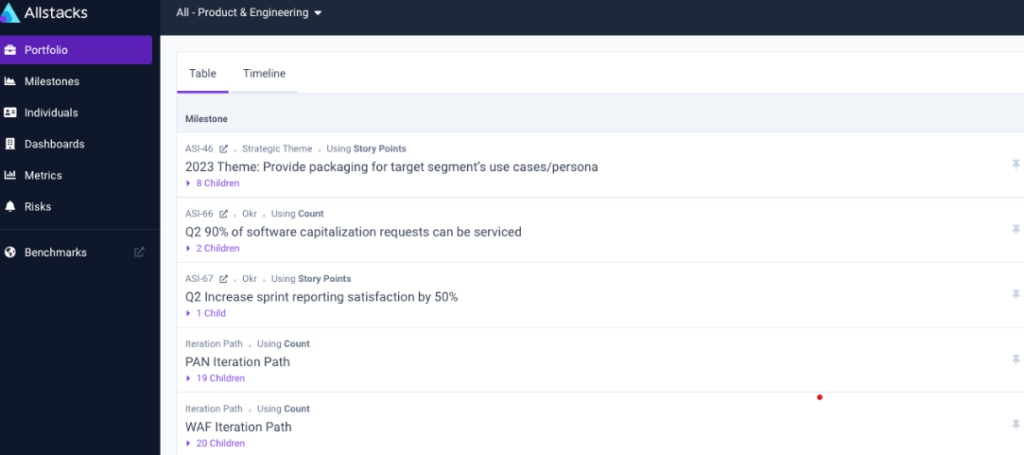
Allstacks is a comprehensive value stream management software that helps organizations streamline their software delivery processes by providing actionable insights and metrics. It enables engineering leaders to optimize workflows, improve team performance, and align engineering efforts with business goals.
- Data Integration: Connects with various tools like Jira, GitHub, and Bitbucket to provide a unified view of the software delivery pipeline.
- Predictive Analytics: Uses machine learning to predict project outcomes and identify potential risks before they become critical.
- Performance Metrics: Tracks key performance indicators (KPIs) such as cycle time, deployment frequency, and mean time to recovery (MTTR).
- Custom Dashboards: Allows users to create custom dashboards to visualize data and track progress in real-time.
- Collaboration Tools: Facilitates improved communication and collaboration among team members by providing insights into bottlenecks and inefficiencies.
- Security and Compliance: Ensures that all data is handled securely and complies with industry standards and regulations.
6. Code Climate Velocity
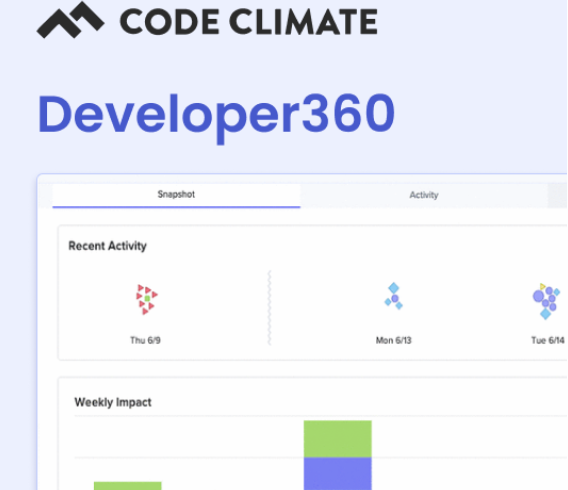
Code Climate Velocity is a software engineering intelligence platform designed to provide actionable insights that help teams improve their operational efficiency and align their work with business goals. It offers concrete data-driven metrics to identify bottlenecks, enhance collaboration, and ensure predictability in software delivery.
- Data-Driven Insights: Uses data from GitHub to provide actionable insights for teams to identify bottlenecks and improve efficiency.
- Operational Efficiency: Helps teams enhance their operational efficiency by aligning R&D activities with business objectives.
- Collaboration Tools: Facilitates better team collaboration by providing metrics that highlight areas for improvement.
- Predictability: Enables teams to deliver more predictable results by tracking and measuring key performance metrics.
- Real-Time Metrics: Provides real-time metrics and dashboards to monitor progress and performance continuously.
- Integration: Seamlessly integrates with existing tools and workflows, making it easy to implement without disrupting current processes.
7. HCL Accelerate
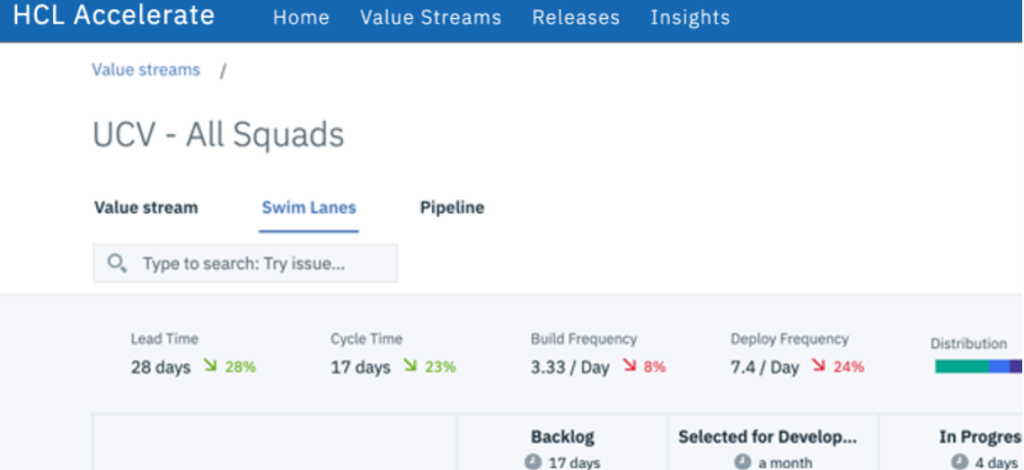
HCL Accelerate is a powerful value stream management software that enhances DevOps efficiency by providing real-time visibility and analytics across the entire software delivery lifecycle. It integrates seamlessly with popular tools like Jira, enabling teams to identify bottlenecks, optimize workflows, and improve throughput. With its advanced features, HCL Accelerate empowers organizations to maximize their DevOps investments and achieve continuous delivery at scale.
- Real-time Analytics: Provides actionable insights with real-time metrics and analytics to optimize the software delivery process.
- Seamless Integration: Easily integrates with popular tools such as Jira, Jenkins, and GitHub, ensuring smooth data flow across the DevOps pipeline.
- Automated Workflows: Automates project management tasks to streamline workflows and enhance team productivity.
- Bottleneck Identification: Identifies bottlenecks in the development process, helping teams to address issues proactively and maintain delivery timelines.
- Release Management: Manages the entire release lifecycle, from planning to deployment, ensuring efficient and error-free releases.
- Data Unification: Unifies data from various sources to provide a comprehensive view of the development process, enabling informed decision-making.
8. Pluralsight Flow
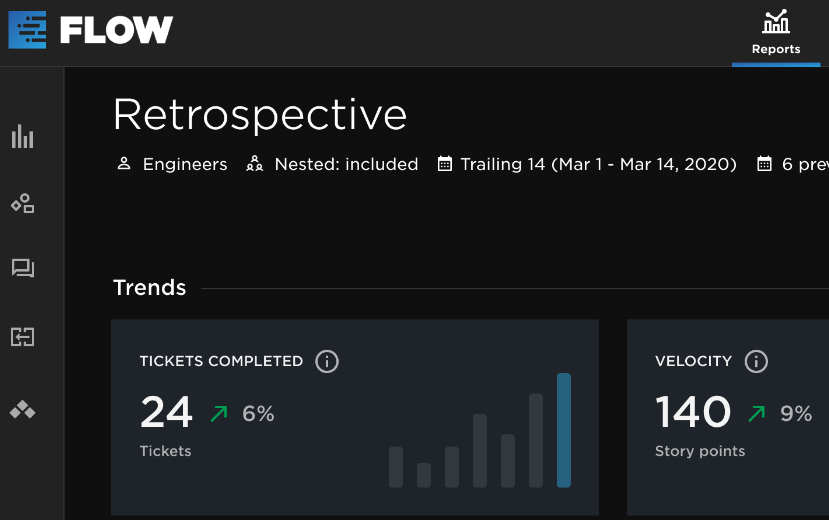
Pluralsight Flow is an advanced value stream management tool designed to enhance team productivity by providing deep insights into workflow patterns and efficiency. It helps engineering leaders identify bottlenecks, compare trends, and advocate for their teams using actionable data. By leveraging Pluralsight Flow, organizations can accelerate product delivery and improve overall quality.
- Workflow Visualization: Provides a detailed visual representation of the entire workflow, highlighting bottlenecks and inefficiencies.
- Productivity Metrics: Tracks key performance indicators such as cycle time, throughput, and lead time to measure team productivity.
- Trend Analysis: Offers comprehensive trend analysis to help teams understand performance over time and make data-driven decisions.
- Team Collaboration: Enhances collaboration by providing a unified view of the value stream, enabling better communication and coordination.
- Integration Capabilities: Seamlessly integrates with popular development tools like GitHub, Jira, and Bitbucket to provide a holistic view of the development process.
- Actionable Insights: Delivers actionable insights and recommendations to help engineering leaders make informed decisions and drive continuous improvement.
9. CloudBees
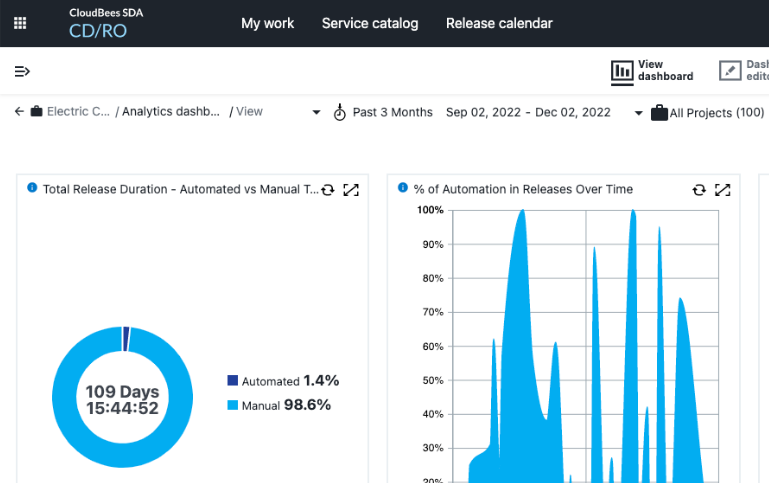
CloudBees is a top-notch value stream management platform that provides comprehensive CI/CD solutions, enabling enterprises to streamline software development and delivery processes. With its robust tools and insights, CloudBees enhances visibility, optimizes workflows, and accelerates innovation across the software delivery lifecycle. The platform supports organizations in achieving higher productivity, reducing risks, and driving continuous improvement.
- Continuous Integration and Delivery (CI/CD): Streamlines development and deployment processes, ensuring faster and more reliable software releases.
- End-to-End Visibility: Provides comprehensive insights into the software delivery pipeline, helping teams identify bottlenecks and optimize performance.
- Scalability: Supports enterprise-scale operations with robust infrastructure and scalable solutions, accommodating the needs of growing organizations.
- Automation: Automates repetitive tasks, enhancing efficiency and allowing teams to focus on higher-value activities.
- Security: Ensures secure paths to production with integrated security practices, minimizing risks and ensuring compliance.
- Integration: Seamlessly integrates with a wide range of development tools, including Jenkins, GitHub, and Jira, enabling cohesive workflow management.
10. Opsera
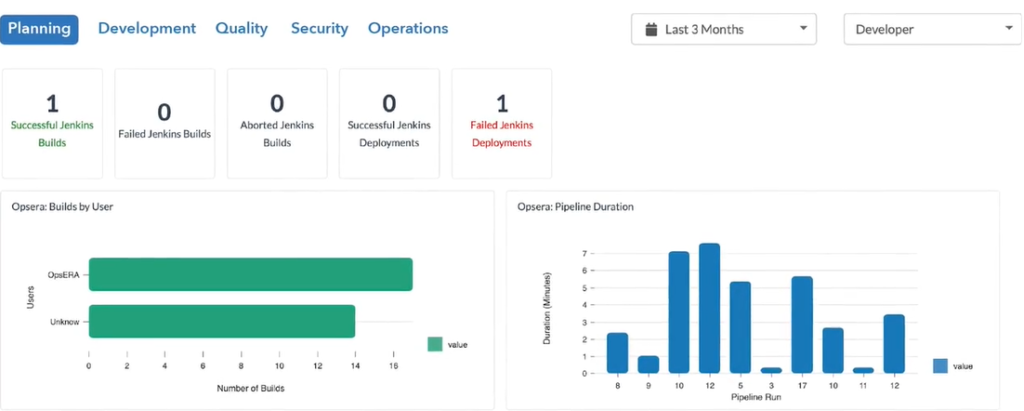
Opsera is a comprehensive value stream management platform designed to enhance software delivery by providing end-to-end visibility and automation across the development lifecycle. It offers a no-code DevOps orchestration platform that enables organizations to streamline their software delivery pipelines and optimize for business outcomes.
- No-Code Orchestration: Automate and manage your CI/CD pipelines with a no-code interface, enabling rapid deployment and configuration.
- Integrations: Seamlessly integrates with popular DevOps tools like Jenkins, GitHub, and Kubernetes to unify your DevOps ecosystem.
- Real-Time Analytics: Provides actionable insights and analytics to monitor and optimize software delivery performance in real-time.
- Compliance and Security: Ensures compliance and security across the DevOps pipeline with built-in security policies and governance controls.
- Customizable Dashboards: Offers customizable dashboards to visualize key metrics, identify bottlenecks, and improve decision-making.
- Scalability: Designed to scale with enterprise needs, supporting large and complex environments with ease.
Future Trends in VSM
As organizations continue to adopt value stream management, several trends are emerging that will shape its future:
Integration with Advanced Technologies
The integration of advanced technologies such as artificial intelligence (AI), machine learning (ML), and the Internet of Things (IoT) is transforming VSM. These technologies provide deeper insights into value stream performance and enable predictive analytics, helping organizations anticipate and address issues before they become critical. For instance, AI and ML can analyze vast amounts of data to identify patterns and predict potential bottlenecks, allowing for proactive management and optimization of value streams. Similarly, IoT devices can provide real-time data on various aspects of the production process, enabling more accurate and timely decision-making.
Focus on Customer-Centricity
Increasingly, organizations are adopting a more customer-centric approach to VSM. By aligning value streams with customer needs and preferences, businesses can deliver more personalized and impactful products and services. This shift towards customer-centricity ensures that all efforts within the value stream are directed towards maximizing customer value and satisfaction. By continuously gathering and analyzing customer feedback, companies can adjust their processes to better meet customer expectations, ultimately driving higher levels of customer loyalty and business success.
Enhanced Collaboration Tools
The development of sophisticated collaboration tools is enhancing the ability of teams to work together seamlessly across the value stream. These tools provide real-time communication, shared workspaces, and integrated data, facilitating more efficient and effective teamwork. Enhanced collaboration tools break down silos within organizations, enabling cross-functional teams to coordinate their efforts more effectively and respond more quickly to changes and challenges. This improved collaboration leads to faster problem-solving and innovation, driving overall productivity and success.
Greater Emphasis on Sustainability
Sustainability is becoming a critical consideration in VSM. Organizations are looking for ways to minimize waste and reduce their environmental impact, aligning their value streams with broader sustainability goals. By adopting sustainable practices, companies can not only reduce their ecological footprint but also enhance their brand reputation and meet regulatory requirements. This emphasis on sustainability involves optimizing resource use, reducing emissions, and implementing eco-friendly practices throughout the value stream. As consumers and stakeholders increasingly prioritize sustainability, integrating these practices becomes essential for long-term business viability.
As technology continues to evolve, VSM will become even more integral to organizational success, providing the tools and insights needed to thrive in a competitive market. With advancements in AI, ML, and IoT, along with a focus on customer-centricity, enhanced collaboration, and sustainability, VSM will continue to drive significant improvements in how organizations operate and deliver value.



















Comments